Facebook Comments Plugin Upgrades – What You Need To Know
The Facebook Comments Box Social Plugin now includes incredible, game-changing features. When you add this plugin to your blog/website, visitors can leave a comment as their Facebook profile or any Page they administer. They can choose to have their comment posted to their Facebook wall (Profile or Page, depending upon how they made the comment). The comment also publishes to the News Feed of their friends/fans. To quote Facebook:
Distribution: Comments are easily shared with friends or with people who like your Page on Facebook. If a user leaves the “Post to Facebook” box checked when she posts a comment, a story appears on her friends’ News Feed indicating that she’s made a comment on your website, which will also link back to your site.
Friends and people who like the Page can then respond to the discussion by liking or replying to the comment directly in the News Feed on Facebook or in the Comments Box on your site. Threads stay synced across Facebook and on the Comments Box on your site regardless of where the comment was made.
These screenshots were taken from TechCrunch‘s post on this subject. To leave a comment on a website/blog that has the new Comments Box Social Plugin, just click “Add a comment” and the text field opens up. If you’re logged into Facebook as your personal profile, you’ll see confirmation that you’re posting as yourself. There is an option to change this as you can see in Step 2 below. And in Step 3 – you’ll see a dropdown with any fan Pages you administer.
The really cool part is when anyone comments on the comment inside of Facebook, that comment instantly ports over to the original blog post/web page! And, conversely, additional comments made on the original comment sync back to Facebook. In other words, whether comments are made inside or outside of Facebook, the thread is synchronized in both places. Same goes for likes on the comments. 🙂
This is an awesome way to create *significantly* more engagement. Plus, when you make regular comments as your Page on popular blogs, you’ll be able to bring much more visibility and traffic to your Facebook Page.
The screenshot below was taken from my Facebook Page wall – it’s the comment I made on TechCrunch’s post that then auto-posted to my Page wall and ensuing comments synced in both places (plus in the stream of fans). As you can see, Facebook makes it clear that you’re actually posting onto the original site/blog as well, per the “Comment on (site name)” button.
Social Relevance
Something of note: first line comments on the original post are displayed according to social relevance – meaning that you’ll see comments made by friends above those made by non-friends. I’m not sure how happy Facebook users will be about this, given the pushback about non-chronological Page wall posts*… but, we’ll see! It actually encourages even more engagement when you see people you know leaving comments – I know I feel more inclined to add a reply to people I know vs. those I don’t know.
*Facebook Page wall posts now have a new filter – see top right of your wall: (Page Name) and Top Posts with a little arrow next to it. Click that to then switch to Most Recent – aka chronological order! See my post that I’ve now updated at: Essential Guide To Facebook Page Changes [SCREENSHOTS]
Adding the Comments Box Plugin
My guess is many savvy bloggers will be adding the Comments Plugin to their blog… and may well decide to replace systems like Disqus or Livefyre. That is, unless these third party systems are somehow able to integrate the upgraded Facebook Comments Plugin. Hmm! (Much as I love Disqus, I may choose to use the new Facebook Comments tool instead/as well… soon!)
Get the code for the Facebook Comments Box Social Plugin here.
Check out Facebook’s video below about the Comments upgrades. Plus, See TechCrunch’s post to give the new Comments a test run.
Moderation Tools
The Comments Plugin includes moderation tools so when you add the Plugin to your blog/website, you can keep any spam under control. Given users are posting as their Facebook Profile or Page, there’s actually less chance of trolls and spammers troubling you on your blog. Love that!
According to InsideFacebook.com:
The moderation settings allow admins to add other admins or moderators, use a standard keyword blacklist, create a custom blacklist, set common grammar mistakes to be auto-corrected, and permit or deny third-party logins. They can also set the moderation mode to “Make every post visible to everyone by default” or “Let me approve each comment before it’s shown to everyone”.
Aha, as I was completing this post, a rather nasty comment showed up on my comment thread of TechCrunch’s post. Fortunately, one of my buds alerted me via DM and I was able to go in and report/remove/ban the person from my fan Page. I’m not entirely sure if that ban then prevents the same person from returning to the original post or if they would need to be banned by the Admin of the blog with the Plugin. Hm.
Also, though I have my Page Profanity filter enabled, the troll put spaces into their expletives so it didn’t trip the filter. Interesting. More words to add to the Moderation Blocklist!
With these comment threads now having extensive visibility potential by showing up both on Facebook (walls and News Feeds) and on the originating post, moderating duties now just expanded… again. But, fortunately, we can moderate on our Profile/Page or the blog and both places retain any changes made.
Notifications
When Facebook users comment on your comment, you’ll get a notification on Facebook. What’s interesting to note is that the link in the notification takes you back to the original post.
Are there any downsides?
Possibly these six:
1) LIMITED LOGINS: Some users may be resistant to putting all their comments into one giant Facebook basket. At present, Facebook does offer the option to login through your Yahoo ID and indicates that additional logins are coming. Certainly, Twitter and Google would be great. (See TechCrunch’s post for more on this aspect). But, still, I do like Disqus!
2) PAGE MODE: When you’re using Facebook in Page mode, the Comments Box Social Plugin completely disappears. This has been a bug with all plugins since the Page Upgrades on February 10th. The Like Button and Like Box, most notably, vanish when viewing sites in Page mode. Presumably, Facebook are working on these bugs.
3) SEO: When you comment on blogs, typically your comment is linked to your own website/blog giving you added visibility and search engine optimization. But, if a blog switches to the upgraded Facebook Comments Plugin only, you’re adding to Facebook’s SEO. Which, of course, when posting as your Page can be a good thing. 😉
4) FACEBOOK BLOCKED: Users would not be able to comment if their workplace or country blocks Facebook. (Props to InsideFacebook for this).
5) LOAD TIME: With a large number of comments, this does seem to slow down the page load time.
6) BUGS: As this is a brand new upgraded plugin, it’s a bit buggy. I noticed on a few refreshes (of TechCrunch’s post), often all but one of the comments was truncated and I couldn’t access the buttons in order to make a comment. I’m sure the Plugin will become more stable over time.
Change your Employer to your Official Page
One tip I want to make sure you know about is to ensure the Employer field on your personal Facebook Profile has been correctly linked to your official fan Page (assuming you’d like it that way!). Why? Because any time you post a comment as your personal profile on third party sites via the upgraded Facebook Comments tool, your employer link automatically posts too.
In the screenshot below, my buddy, Dave Kerpen, has added a comment on TechCrunch’s post via his personal profile. Alongside Dave’s name, you can see “CEO at Likeable Media” which is hyperlinked to his fan Page. This information is pulled from the Employer section of our personal Profiles.
When Facebook upgraded Profiles to the new design, the Employer field automatically hyperlinked to a Community Page. I recommend changing this to your official fan Page for extra exposure and marketing. Click Edit Profile > Education and Work > then see if you can just type the name of your fan Page and select from the dropdown menu. It can be tricky! If that doesn’t work, try typing in the full URL of your Page. If that doesn’t work, W Ching Ya has a great tutorial that is a bit tecchie but it does work!
Of course, you may choose to post comments as your Page when using the new Facebook Comments Plugin, in which case there is no additional information/links. Just your Page, which is great.
Let me know your thoughts on this awesome upgrade to the Comments Plugin. I really feel it’s another step forward for Facebook as the next generation Internet. Like it or not, Facebook is becoming truly ubiquitous across the web – not just the social network web, but Facebook is turning the entire world wide web into one giant social site. What do you think?
Related posts:
- Facebook Now Powers Comments All Around the Web (readwriteweb.com)
- Facebook Rolls Out Overhauled Comments System (Try Them Now On TechCrunch) (techcrunch.com)
- Facebook’s New Comments Box Plugin Filters Website Comment Reels by Relevance (insidefacebook.com)
- Facebook Releases Robust Updates to Its Comments Plugin (mashable.com)



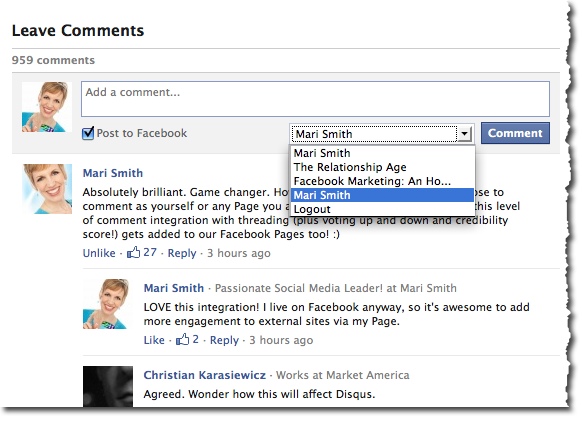
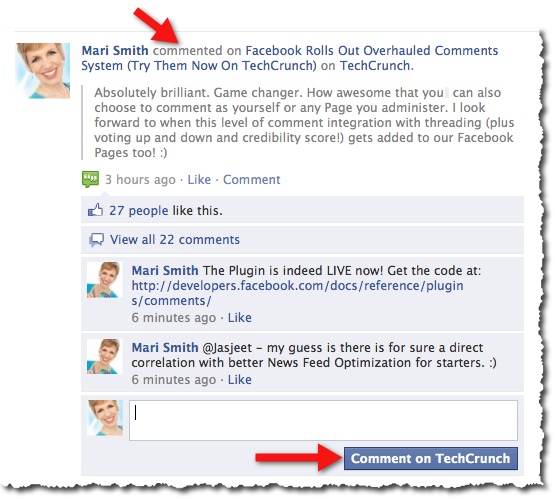
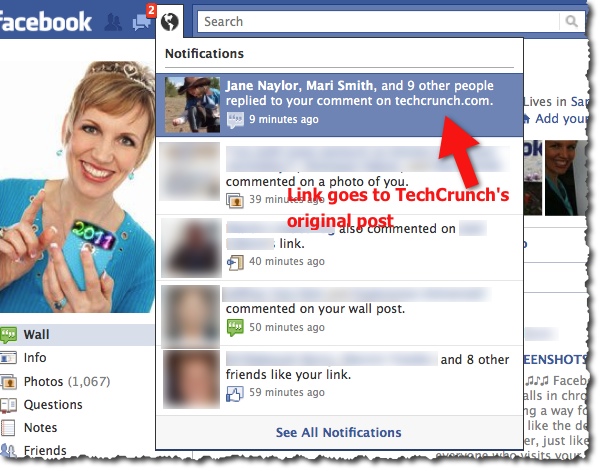
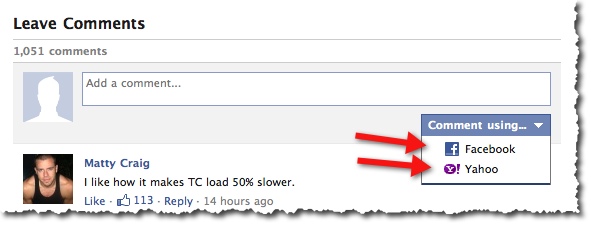
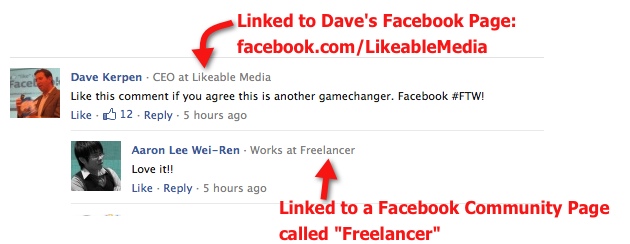
One of my biggest concerns is Facebook blocking by employers/institutions! This would seem to be almost insurmountable…I hope Disqus can integrate the new Facebook comments – that would be the best! @bragTAG @joninc
Exactly!! Totally agree — I’m a huge Disqus fan and I would love for us blog owners to have a simple integration with the new FB Comments Plugin without leaving Disqus.
Mari – thanks for this post! I’ve added it to my blog now to see how it works ove rthe next few weeks. I don’t like the extra spacing it causes underneath the box (in my theme anyways) and will need to address that soon.
Aha – coolio! Looks great. I see what you mean by the extra space, but I’m a big fan of extra whitespace. 😉 Keep us posted on how it works out for you!
Mari, I’ve been working with the new comments function and it IS buggy. Looking forward to getting the kinks out. In addition, I’ve never been able to link my page to my profile as you advise. It always turns into a community page. I’ve tried everything and probably have quite a few Meticulously Clean community pages out there if it creates a new one every time I try. 😛
Trying again now. Maybe it fixed itself. It happens!
LOL re all the Community Pages. Phew! I did find the Web Developer Toolbar works great. It’s not as tecchie as it looks. 🙂
Fantastic article….full of helpful tips and insights for Page admins. I will also be seriously considering the switch over from Disqus.
Thanks heaps, Russ!! Fingers crossed Disqus is able to do a nice clean integration then we have the best of all worlds. I’m guessing it would be quite easy seeing as we already have that option to “Share on T F” below each comment!
I had tried to add my Fan Page to my personal profile Employer as you suggested and it wasn’t working. I followed your link and read W Ching Ya’s tutorial. As I was working through those steps I realized that it could be the special characters I had in my Fan Page title. It was Denise Sonnenberg | Social Media Dot Connection. As soon as I removed the | character I was able to add it the easy way, by just typing in the new name of the page. Yea! Thought this might help others.
I was going to write a note about “meta redirect” (sounds boring, yeah?), but there’s so much going on with Facebook these days…
What do you say about the new facebook comments? I think they’re brilliant!
Great post, Mari! As always! Thank you!
Ekaterina
@ekaterina
I was rather liking this new comments plugin until I saw that disgraceful comment response to your Techcrunch comment also appear on YOUR wall. I would really like to know what effect your banning someone from your own wall has on people responding to your comments on other people’s properties before I adopt this plugin. I’d also like FB to fix the bug that prevents buttons and boxes from appearing when you log in as a page.
So true, David. I got such a shock with that awful comment. I was so grateful for the headsup! And, even with my Page profanity filter on, it posted… but then it would’ve anyway even with the tightest filters because of the way the person wrote the words. Odd.
The good news is as I was reading the post on InsideFacebook’s site, I see the Admin moderation features are quite extensive. So, really, this would be an issue for TechCrunch to have blocked that abusive person. I rather suspect that they could come along and post again and that my FB Page ban would have no bearing on the original post… except maybe that they wouldn’t even see my comment if made from my Page? Hmmm. Such complexity!!
Can this be added to your fan page and when people comment it shows up on your wall?
Hi Craig – absolutely! No reason why you couldn’t add any of the Facebook Plugins to an iFrame right on your Page. 🙂
I’m not sure how anyone can comment as their page since there is a bug right now that keeps Facebook “like” buttons, fan boxes and comments from being visible on a website or blog page if you’re logged into Facebook as your page and not your personal identity.
Hey there Hugh – ya, I mention this bug in my post. I sure hope Facebook fixes it sooooon!!
Good news with the Comments Plugin though: you do not have to be in Page mode to comment as your Page. See the 3 screenshot tutorial: when viewing a blog that has the new FB Comments Plugin, and whilst logged into Facebook in Profile mode, just click on Change and a dropdown menu shows with any Pages you administer. Voila! 🙂
Yeah, the problem is that I’m rarely logged into Facebook as my profile anymore, so when I’m surfing blogs I don’t see the Facebook stuff, including the comments and I’m going to have to be really motivated to read the comments or post one to go back to Facebook to switch to my personal profile.
I agree with you Hugh. Plus, I think Mari benefits from our conversation on this thread way over the FB comments thread. Depends on where you want your community to play I guess.